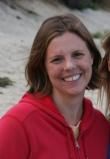Electron Transfer Chemistry in Sulfite Reductase
Dr. Elizabeth Stroupe — January 2014
Every day in nature, innumerable times, chemical conversions change sulfite compounds into hydrogen sulfide. Despite nature’s fluency with the process, scientists still have a hard time recreating the process efficiently in a laboratory setting.
In order to gain a deeper understanding of how this process works, Dr. Beth Stroupe and her team at the Stroupe Lab in the Florida State University Microbiology Department are using big data to study a microscopic substance: the molecular structure of sulfite reductase, a central enzyme in the sulfur metabolic cycle. Learning about sulfite reductase will teach basic principles about how enzymes catalyze this type of chemical reaction, which is called an electron transfer reaction. These chemical reactions are to the cell like the electrical wiring is to a house, they power the cell. To achieve this, Stroupe’s team uses an extremely advanced instrument called a cryo-electron microscope. The microscope allows high resolution imaging of individual proteins and molecular machines, which is the perfect tool for taking a closer look at sulfite reductase in 3D.
Detailed images from the microscope are transferred automatically onto Research Computing Center (RCC) filesystems via an automated process setup by the RCC, the biology and chemistry departments, and the Institute of Molecular Biophysics – so detailed that a typical transfer may consist of up to a terabyte of data. Scientists then use a number of software tools on the High Performance Computing Cluster to transform the data so that it may be analyzed. “Since the images can be represented as a two-dimensional array of gray scale pixel values, we can do statistical analyses on the orientation of the pixels to learn something about what the molecules look like,” states Stroupe.
The RCC allows the lab to take advantage of this big-scale technology without worrying about the management of all of the pieces. According to Stroupe, “It means that I don’t have to be a computer scientist. I can focus on the biology, and on training my students.”

